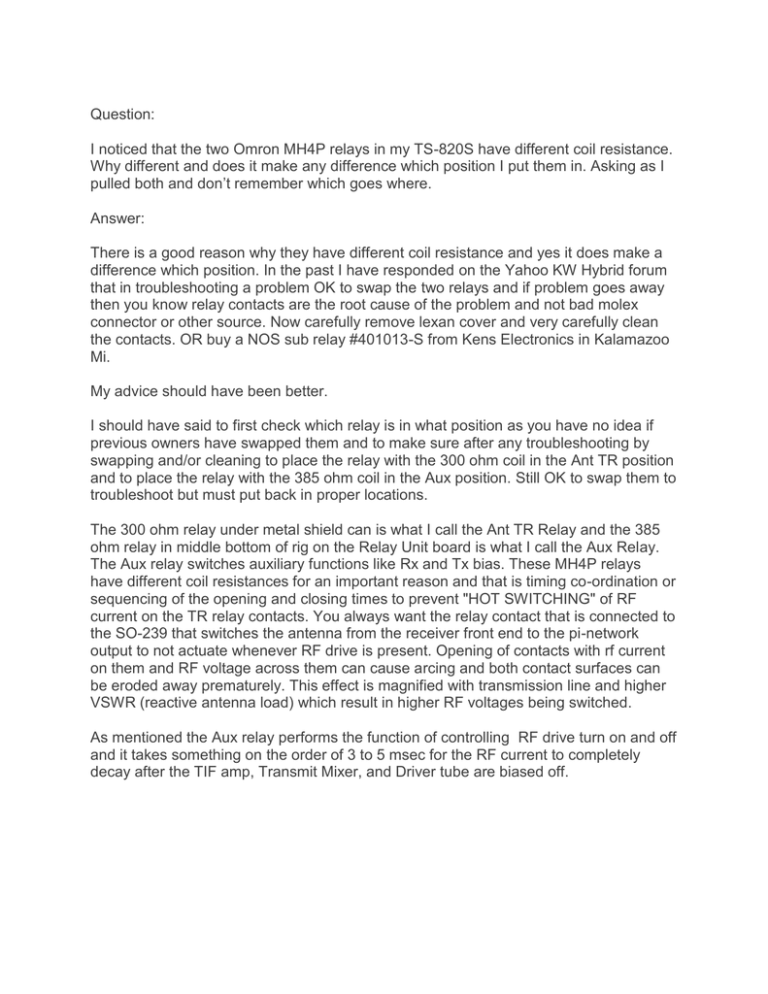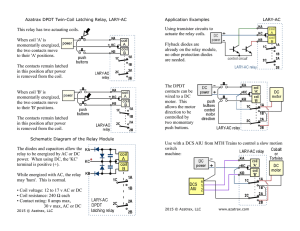Kenwood TS820S MH4P Relays
advertisement

Question: I noticed that the two Omron MH4P relays in my TS-820S have different coil resistance. Why different and does it make any difference which position I put them in. Asking as I pulled both and don’t remember which goes where. Answer: There is a good reason why they have different coil resistance and yes it does make a difference which position. In the past I have responded on the Yahoo KW Hybrid forum that in troubleshooting a problem OK to swap the two relays and if problem goes away then you know relay contacts are the root cause of the problem and not bad molex connector or other source. Now carefully remove lexan cover and very carefully clean the contacts. OR buy a NOS sub relay #401013-S from Kens Electronics in Kalamazoo Mi. My advice should have been better. I should have said to first check which relay is in what position as you have no idea if previous owners have swapped them and to make sure after any troubleshooting by swapping and/or cleaning to place the relay with the 300 ohm coil in the Ant TR position and to place the relay with the 385 ohm coil in the Aux position. Still OK to swap them to troubleshoot but must put back in proper locations. The 300 ohm relay under metal shield can is what I call the Ant TR Relay and the 385 ohm relay in middle bottom of rig on the Relay Unit board is what I call the Aux Relay. The Aux relay switches auxiliary functions like Rx and Tx bias. These MH4P relays have different coil resistances for an important reason and that is timing co-ordination or sequencing of the opening and closing times to prevent "HOT SWITCHING" of RF current on the TR relay contacts. You always want the relay contact that is connected to the SO-239 that switches the antenna from the receiver front end to the pi-network output to not actuate whenever RF drive is present. Opening of contacts with rf current on them and RF voltage across them can cause arcing and both contact surfaces can be eroded away prematurely. This effect is magnified with transmission line and higher VSWR (reactive antenna load) which result in higher RF voltages being switched. As mentioned the Aux relay performs the function of controlling RF drive turn on and off and it takes something on the order of 3 to 5 msec for the RF current to completely decay after the TIF amp, Transmit Mixer, and Driver tube are biased off. If you look at the MH4P relay in the TR position you will see it has 300ohm coil which means approx 40ma current and it will switch faster as it will develop higher current which means higher flux concentration. However, it will also then switch back slower as the flux field will decay slower when the coil voltage is removed. We want this relay to close before RF drive is turned on to the final tubes and we want it to open after RF drive is turned off and RF current has decayed. Lastly if you look closely at the contacts on this MH4P relay you will see one contact that is about 2x the size of all the other contacts. Again this is by design to handle the RF current. Normally at 100 watts output approx 1.4 rf amps into 50 ohm dummy load. If you look closely at the lexan case on the 300 ohm TR relay you should see the letters TRI-2. This is another clue that it belongs in the Ant TR position under the shield can. By the way you won’t find this info in the MH4P data sheets that I have been able to locate. Perhaps Omron made these special MH4P relays for KW? The Aux relay has no such lettering on the lexan case unless previous owner has switched the covers during cleaning exercise. The coil resistance on the Aux relay is 385 ohms which means approx 30ma coil current and slower actuation time and faster contact opening time than the TR relay. To understand this hit the books and refresh yourself on inductors and ELI the ICE man and what happens to current and the flux field in an inductor when it is energized and de-energized. OK both relays are obsolete. You can use Kens Electronics Fujitsu NOS sub #401013-S which has a 235 ohm coil (50ma). I would place it in the Ant TR location as it should close faster and open slower. However, it does not have that one heavy contact. I would not use it in the Aux position. I have installed this relay in customer’s radios after advising them it is not an exact sub and I cannot guarantee that it will have similar number of trouble free actuations as the original Omron relay. Summary: There is a design reason why the two MH4P relays have different coil resistances and one heavier contact. Place the 300 ohm unit in the Ant TR location and the 385 ohm unit in the Aux position. OK to swap for troubleshooting and then swap back. OK to clean and if can’t improve contact resistance with paper wetted with Deoxit go ahead and burnish with diamond point file (nothing more abrasive than this or could remove design contact coatings). OK to install Kens NOS sub in the Ant TR position. However, realize its contacts may not last as long as original. 1. Will the rig work if you swap the relays? Certainly. 2. Will it accelerate contact wear? Of course. 3. Will that be measurable? It depends on your length of transmission line and reactive antenna loads you are switching and what condition contact is presently in. Might accelerate contact deterioration by factor of 100X? Short answer is I don’t know, but my guess is we are not talking hours, days or weeks here. It might be good idea to buy couple of used pulls off Ebay when they become available and clean the contacts and have them available. 4. Is there any way I can measure the contact resistance and what should it be? Yes can use the "6-1" test by applying approx 6vdc across each set of closed contacts and limiting the current to 1amp with series resistor or lite bulb. Then use a DMM to measure the millivolt IR drop across the contacts. Should be under approx 100 millivolts which equates to 100 milliohms. Most hams do not have a milli-ohm meter and simply measure contact resistance with an ohm meter and that is not a good test. 5. Can I electrically clean the contacts if chemical cleaning doesnt help? Yes use a little more power. Suggest trying 12vdc current limited to probably no more than 2 amps and applying across the contact and keying the relay multiple times and then repeat measuring the mv drop across the contact to see if getting any improvement ie lowering the mv reading. Some of what you may be seeing is relay contact actuation leaf damage due to rough cleaning operations and almost impossible to get them back to factory new position, tension etc. Sorry so long and sorry if I previously advised anyone that it was OK to swap the two relays without telling you to make sure to swap them back in to the correct positions so that they can perform the relay timing sequence that KW design engineers intended. Dont worry about the TS530 and TS830 relays. Need same relay sequencing to avoid hot switching the TR relay but two very different relays are employed and not possible to switch their positions. Of course some other issues with these two relays (MX2P and LZN4) which have been more than adequately addressed on the KW hybrid reflector. Terry K9TW Dec 2014

